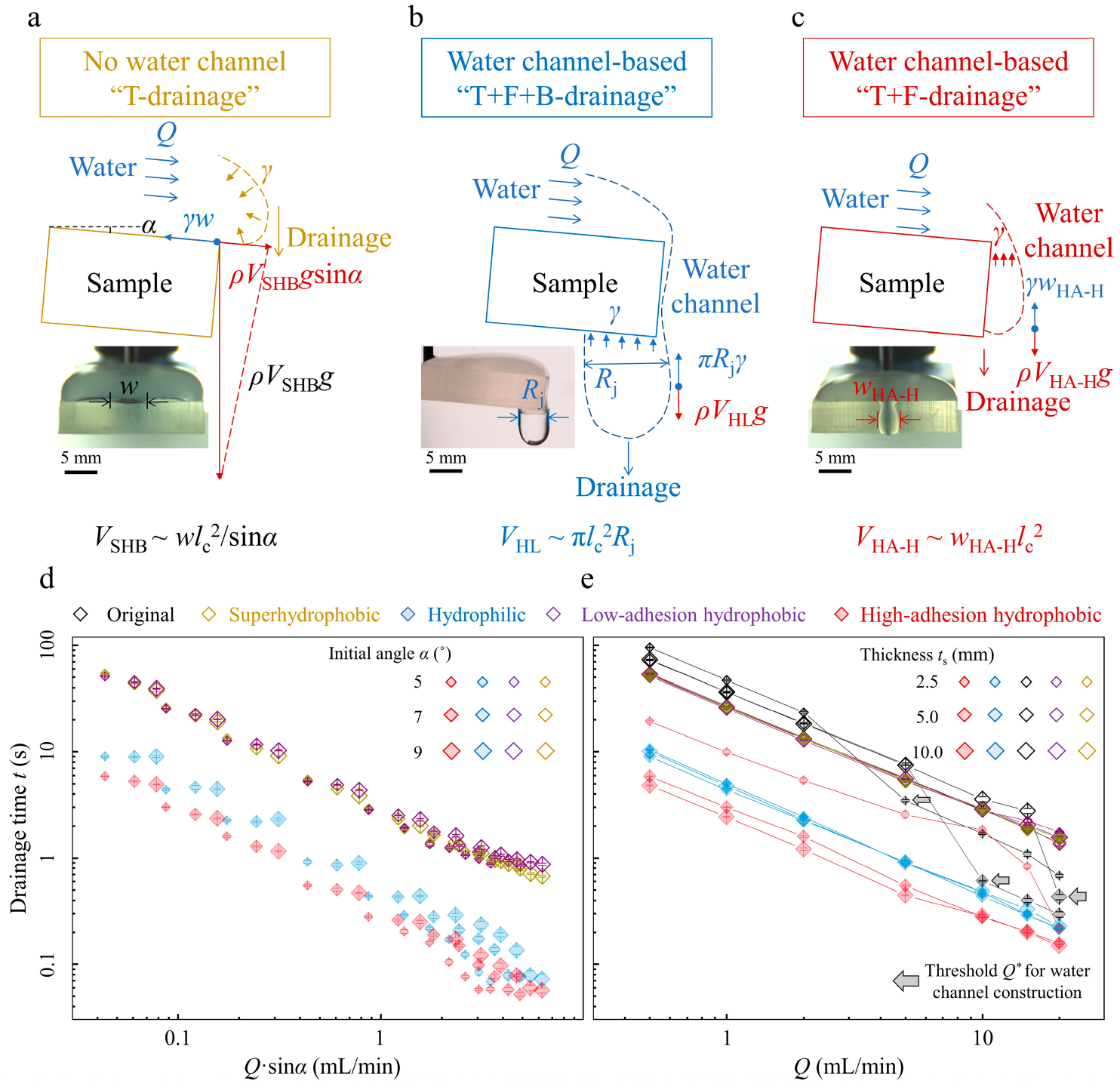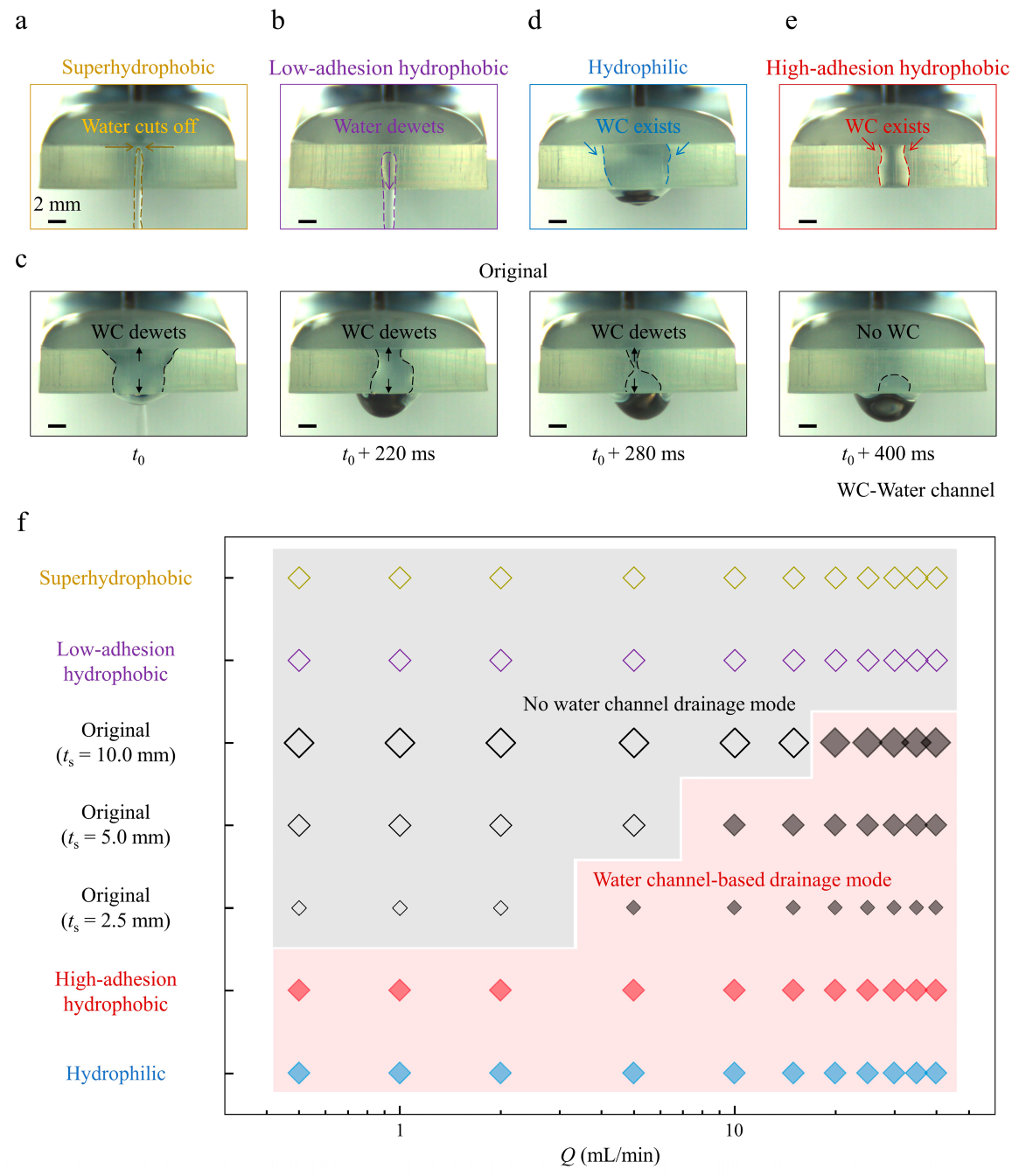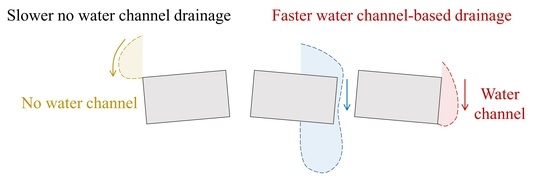Effect of Wettability and Adhesion Property of Solid Margins on Water Drainage
Abstract
1. Introduction
2. Materials and Methods
2.1. Experimental Setup
2.2. Fabrications and Characterizations of Experimental Samples
3. Results and Discussion
3.1. Drainage Results and Drainage Mode Comparisons
3.2. Drainage Mechanisms and Experimental Parameters Regulating Different Drainage Modes
3.3. Critical Drainage Snapshots and Phase Maps of the Two Drainage Modes
4. Conclusions
Supplementary Materials
Author Contributions
Funding
Institutional Review Board Statement
Informed Consent Statement
Data Availability Statement
Conflicts of Interest
References
- Park, K.C.; Kim, P.; Grinthal, A.; He, N.; Fox, D.; Weaver, J.C.; Aizenberg, J. Condensation on Slippery Asymmetric Bumps. Nature 2016, 531, 78–82. [Google Scholar] [CrossRef] [PubMed]
- Feng, S.L.; Delannoy, J.; Malod, A.; Zheng, H.X.; Quéré, D.; Wang, Z.K. Tip-Induced Flipping of Droplets on Janus Pillars: From Local Reconfiguration to Global Transport. Sci. Adv. 2020, 6, eabb4540. [Google Scholar] [CrossRef] [PubMed]
- Li, J.; Ran, R.; Wang, H.; Wang, Y.; Chen, Y.; Niu, S.; Arratia, P.E.; Yang, S. Aerodynamics-Assisted, Efficient and Scalable Kirigami Fog Collectors. Nat. Commun. 2021, 12, 5484. [Google Scholar] [CrossRef] [PubMed]
- Bintein, P.B.; Lhuissier, H.; Mongruel, A.; Royon, L.; Beysens, D. Grooves Accelerate Dew Shedding. Phys. Rev. Lett. 2019, 122, 098005. [Google Scholar] [CrossRef]
- Duez, C.; Ybert, C.; Clanet, C.; Bocquet, L. Wetting Controls Separation of Inertial Flows from Solid Surfaces. Phys. Rev. Lett. 2010, 104, 084503. [Google Scholar] [CrossRef]
- Dong, Z.C.; Wu, L.; Li, N.; Ma, J.; Jiang, L. Manipulating Overflow Separation Directions by Wettability Boundary Positions. ACS Nano 2015, 9, 6595–6602. [Google Scholar] [CrossRef]
- Dong, Z.; Wu, L.; Wang, J.; Ma, J.; Jiang, L. Superwettability Controlled Overflow. Adv. Mater. 2015, 27, 1745–1750. [Google Scholar] [CrossRef]
- Jambon-Puillet, E.; Bouwhuis, W.; Snoeijer, J.H.; Bonn, D. The Liquid Helix. Phys. Rev. Lett. 2019, 122, 184501. [Google Scholar] [CrossRef]
- Feng, L.; Li, S.; Li, Y.; Li, H.; Zhang, L.; Zhai, J.; Song, Y.; Liu, B.; Jiang, L.; Zhu, D. Super-Hydrophobic Surfaces: From Natural to Artificial. Adv. Mater. 2002, 14, 1857–1860. [Google Scholar] [CrossRef]
- Dai, X.M.; Sun, N.; Nielsen, S.O.; Stogin, B.B.; Wang, J.; Yang, S.K.; Wong, T.S. Hydrophilic Directional Slippery Rough Surfaces for Water Harvesting. Sci. Adv. 2018, 4, eaaq0919. [Google Scholar] [CrossRef]
- Dickerson, A.K.; Shankles, P.G.; Madhavan, N.M.; Hu, D.L. Mosquitoes Survive Raindrop Collisions by Virtue of Their Low Mass. Proc. Natl. Acad. Sci. USA 2012, 109, 9822–9827. [Google Scholar] [CrossRef] [PubMed]
- Wang, T.; Si, Y.; Dai, H.; Li, C.; Gao, C.; Dong, Z.; Jiang, L. Apex Structures Enhance Water Drainage on Leaves. Proc. Natl. Acad. Sci. USA 2020, 117, 1890–1894. [Google Scholar] [CrossRef]
- Dickerson, A.K.; Mills, Z.G.; Hu, D.L. Wet Mammals Shake at Tuned Frequencies to Dry. J. R. Soc. Interface 2012, 9, 3208–3218. [Google Scholar] [CrossRef] [PubMed]
- Gao, X.; Yan, X.; Yao, X.; Xu, L.; Zhang, K.; Zhang, J.; Yang, B.; Jiang, L. The Dry-Style Antifogging Properties of Mosquito Compound Eyes and Artificial Analogues Prepared by Soft Lithography. Adv. Mater. 2007, 19, 2213–2217. [Google Scholar] [CrossRef]
- Wang, Q.; Yao, X.; Liu, H.; Quere, D.; Jiang, L. Self-Removal of Condensed Water on the Legs of Water Striders. Proc. Natl. Acad. Sci. USA 2015, 112, 9247–9252. [Google Scholar] [CrossRef] [PubMed]
- Wang, L.; Li, J.; Zhang, B.; Feng, S.; Zhang, M.; Wu, D.; Lu, Y.; Kai, J.J.; Liu, J.; Wang, Z.; et al. Counterintuitive Ballistic and Directional Liquid Transport on a Flexible Droplet Rectifier. Research 2020, 2020, 6472313. [Google Scholar] [CrossRef] [PubMed]
- Li, C.X.; Li, N.; Zhang, X.S.; Dong, Z.C.; Chen, H.W.; Jiang, L. Uni-Directional Transportation on Peristome-Mimetic Surfaces for Completely Wetting Liquids. Angew. Chem. Int. Ed. 2016, 55, 14988–14992. [Google Scholar] [CrossRef]
- Si, Y.; Wang, T.; Li, C.; Yu, C.; Li, N.; Gao, C.; Dong, Z.; Jiang, L. Liquids Unidirectional Transport on Dual-Scale Arrays. ACS Nano 2018, 12, 9214–9222. [Google Scholar] [CrossRef]
- Chen, H.; Ran, T.; Gan, Y.; Zhou, J.; Zhang, Y.; Zhang, L.; Zhang, D.; Jiang, L. Ultrafast Water Harvesting and Transport in Hierarchical Microchannels. Nat. Mater. 2018, 17, 935–942. [Google Scholar] [CrossRef]
- Feng, S.L.; Zhu, P.A.; Zheng, H.X.; Zhan, H.Y.; Chen, C.; Li, J.Q.; Wang, L.Q.; Yao, X.; Liu, Y.H.; Wang, Z.K. Three-Dimensional Capillary Ratchet-Induced Liquid Directional Steering. Science 2021, 373, 1344–1348. [Google Scholar] [CrossRef]
- Lv, J.-A.; Liu, Y.; Wei, J.; Chen, E.; Qin, L.; Yu, Y. Photocontrol of Fluid Slugs in Liquid Crystal Polymer Microactuators. Nature 2016, 537, 179–184. [Google Scholar] [CrossRef] [PubMed]
- Lei, W.W.; Hou, G.L.; Liu, M.J.; Rong, Q.F.; Xu, Y.C.; Tian, Y.; Jiang, L. High-Speed Transport of Liquid Droplets in Magnetic Tubular Microactuators. Sci. Adv. 2018, 4, eaau8767. [Google Scholar] [CrossRef] [PubMed]
- Li, N.; Wu, L.; Yu, C.; Dai, H.; Wang, T.; Dong, Z.; Jiang, L. Ballistic Jumping Drops on Superhydrophobic Surfaces Via Electrostatic Manipulation. Adv. Mater. 2018, 30, 1703838. [Google Scholar] [CrossRef] [PubMed]
- Dai, H.; Gao, C.; Sun, J.; Li, C.; Li, N.; Wu, L.; Dong, Z.; Jiang, L. Controllable High-Speed Electrostatic Manipulation of Water Droplets on a Superhydrophobic Surface. Adv. Mater. 2019, 31, e1905449. [Google Scholar] [CrossRef] [PubMed]
- Bouillant, A.; Mouterde, T.; Bourrianne, P.; Lagarde, A.; Clanet, C.; Quéré, D. Leidenfrost Wheels. Nat. Phys. 2018, 14, 1188–1192. [Google Scholar] [CrossRef]
- Bintein, P.-B.; Bense, H.; Clanet, C.; Quéré, D. Self-Propelling Droplets on Fibres Subject to a Crosswind. Nat. Phys. 2019, 15, 1027–1032. [Google Scholar] [CrossRef]
- Li, W.; Tang, X.; Wang, L.Q. Photopyroelectric Microfluidics. Sci. Adv. 2020, 6, eabc1693. [Google Scholar] [CrossRef]
- Dai, H.Y.; Dong, Z.C.; Jiang, L. Directional Liquid Dynamics of Interfaces with Superwettability. Sci. Adv. 2020, 6, eabb5528. [Google Scholar] [CrossRef]
- Ferrand, J.; Favreau, L.; Joubaud, S.; Freyssingeas, E. Wetting Effect on Torricelli’s Law. Phys. Rev. Lett. 2016, 117, 248002. [Google Scholar] [CrossRef]
- Dong, Z.; Ma, J.; Jiang, L. Manipulating and Dispensing Micro/Nanoliter Droplets by Superhydrophobic Needle Nozzles. ACS Nano 2013, 7, 10371–10379. [Google Scholar] [CrossRef]
- De Gennes, P.G.; Brochard-Wyart, F.; Quéré, D. Capillarity and Wetting Phenomena: Drops, Bubbles, Pearls and Waves; Springer: Berlin/Heidelberg, Germany, 2004; pp. 69–71. [Google Scholar]




Disclaimer/Publisher’s Note: The statements, opinions and data contained in all publications are solely those of the individual author(s) and contributor(s) and not of MDPI and/or the editor(s). MDPI and/or the editor(s) disclaim responsibility for any injury to people or property resulting from any ideas, methods, instructions or products referred to in the content. |
© 2023 by the authors. Licensee MDPI, Basel, Switzerland. This article is an open access article distributed under the terms and conditions of the Creative Commons Attribution (CC BY) license (https://creativecommons.org/licenses/by/4.0/).
Share and Cite
Gao, C.; Jiang, L.; Dong, Z. Effect of Wettability and Adhesion Property of Solid Margins on Water Drainage. Biomimetics 2023, 8, 60. https://doi.org/10.3390/biomimetics8010060
Gao C, Jiang L, Dong Z. Effect of Wettability and Adhesion Property of Solid Margins on Water Drainage. Biomimetics. 2023; 8(1):60. https://doi.org/10.3390/biomimetics8010060
Chicago/Turabian StyleGao, Can, Lei Jiang, and Zhichao Dong. 2023. "Effect of Wettability and Adhesion Property of Solid Margins on Water Drainage" Biomimetics 8, no. 1: 60. https://doi.org/10.3390/biomimetics8010060
APA StyleGao, C., Jiang, L., & Dong, Z. (2023). Effect of Wettability and Adhesion Property of Solid Margins on Water Drainage. Biomimetics, 8(1), 60. https://doi.org/10.3390/biomimetics8010060










